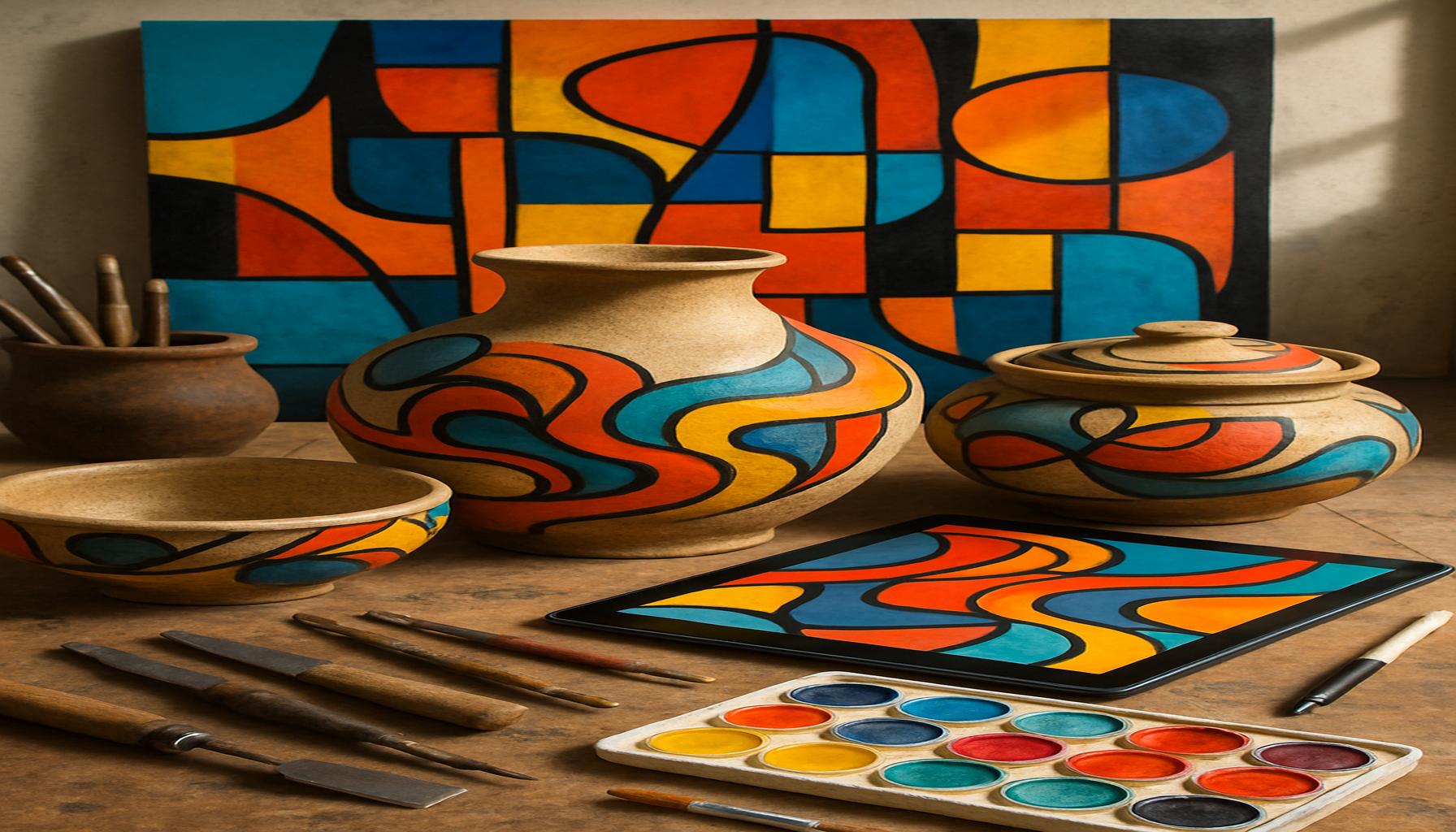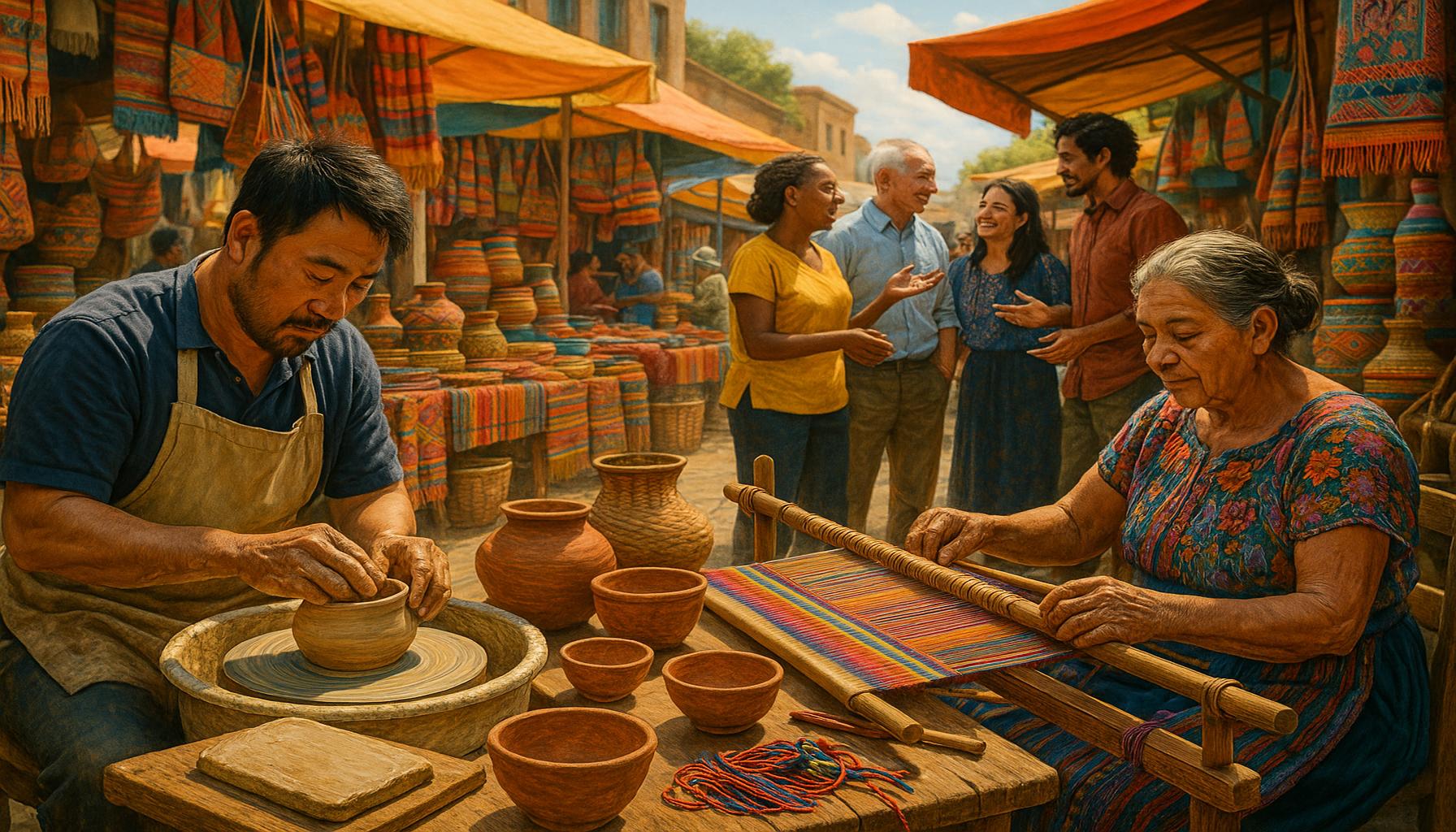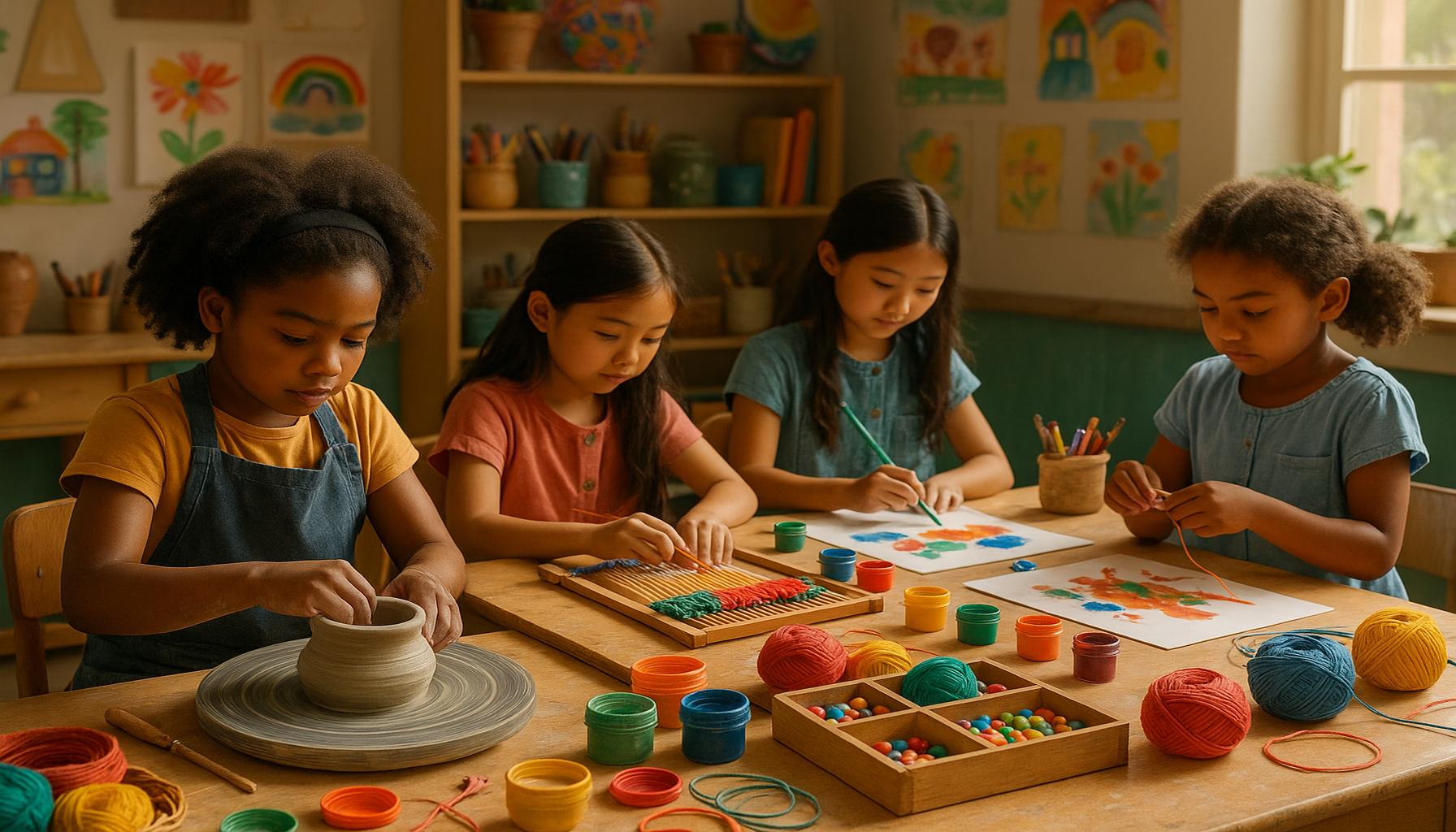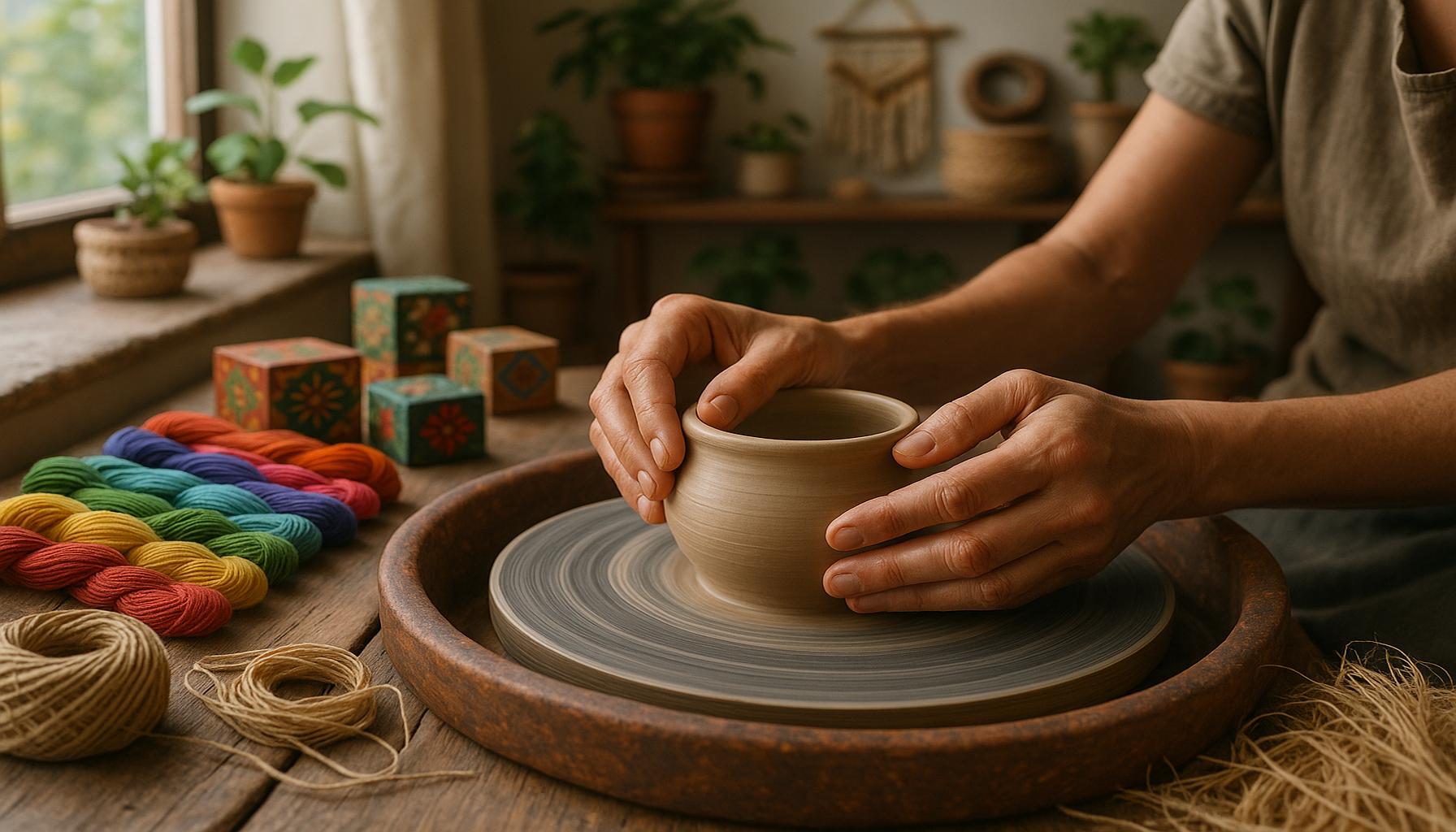The fusion of craftsmanship with modern art: Exploring new forms of creative expression

The Dynamic Landscape of Artistry
Art continues to be a fluid and evolving domain that reflects societal changes, cultural exchanges, and advancements in technology. The current intersection of craftsmanship and modern art is reshaping the way we perceive and engage with creative expressions. This unique fusion is not merely a trend; it represents a significant shift that invites both artists and audiences to expand their definitions of art.
One of the most fascinating aspects of this artistic merger is the emergence of mixed media artworks. Artists are no longer confined to traditional mediums. For instance, contemporary pieces may incorporate found objects, such as scrap metal or fabric, alongside digital components, pushing the boundaries of visual experience. Take the work of U.S. artist Tara Donovan, who famously utilizes everyday materials like plastic cups or Styrofoam to transform spaces into immersive installations that engage viewers both visually and tactilely.
Artisanal techniques also play a pivotal role in this merging of worlds. Traditional practices, such as pottery and textiles, are being reimagined. Artists like Jonathan Adler merge timeless pottery-making techniques with sleek, modern aesthetics, creating functional art pieces like decorative vases that are both visually striking and practical. This integration not only honors age-old skills but also ensures that such craftsmanship remains relevant in today’s design-centric culture.
Another intriguing aspect is the rise of interactive installations. These pieces actively invite viewer participation, transforming passive observers into engaged participants. For instance, the works of artist Ann Hamilton often include components that require audience interaction, like a large textile installation paired with live sound. This convergence creates a communal art experience that redefines how we appreciate and interact with art, turning it into a shared journey.
The exploration of these innovative forms elevates both craftsmanship and modern art to new heights, challenging artists to reassess their roles and responsibilities within their communities. Major exhibitions across the United States are now showcasing these dynamic collaborations. Events such as the American Craft Expo highlight the versatility and creativity of artisans working alongside contemporary artists, offering audiences an exciting glimpse into the evolving landscape of artistry.
As this artistic dialogue continues to flourish, it invites us to reflect on our own relationship with art and creativity. The intersections of craftsmanship and modern art not only enhance our aesthetic experiences but also encourage us to question and redefine the boundaries of what art can be, prompting an ongoing exploration that connects us all.
EXPLORE MORE: Click here to dive deeper
Craftsmanship: A Bridge to New Artistic Realms
The resurgence of craftsmanship within the framework of modern art opens doors to not only redefined aesthetics but also to cultural dialogues that weave old techniques with contemporary expressions. As artists delve into handcrafted techniques, they invoke a sense of authenticity and personal connection that mass production often lacks. In a world dominated by digitalization, this return to manual skill offers a tangible counterpoint, inviting audiences to experience art through a more visceral lens.
One compelling manifestation of this fusion can be found in the realm of textile art. Artists like Faith Ringgold tell stories through quilting, transforming what was once a purely functional craft into a powerful medium for social commentary. Ringgold’s works encapsulate narratives that address race, gender, and history, exemplifying how traditional craftsmanship can serve as a canvas for modern societal issues. The tactile nature of fabric art invites deeper viewer engagement, sparking introspection about both personal and collective identity.
- Weaving Techniques: Many contemporary artists experiment with weaving to create immersive installations, blending color, texture, and form.
- Handmade Ceramics: Potters like Ben Medansky merge age-old ceramic techniques with whimsical forms that challenge conventional notions of function and design.
- Glass Blowing: Artists like Dante Marioni fuse traditional glass blowing with sculptural artistry, crafting pieces that are not only visually stunning but also imbued with narrative depth.
As we observe these innovative practices, it becomes evident that modern art is not merely a departure from the past; rather, it serves as a dialogue with historical techniques and cultural heritage. Artists today are embracing the ethos of handcraft, incorporating its principles into mixed media works that are as much about process as they are about product. This shift allows for a greater exploration of identity and context.
The impact of technology cannot be overlooked in this discussion. Digital art platforms are enabling artisans to share their work on a global scale, creating communities that transcend geographical boundaries. Instances of artists utilizing 3D printing technology illustrate the seamless blend of traditional artistry with modern methodologies. For example, craftspeople can now produce intricate patterns inspired by ancient art forms while employing cutting-edge technology to expand the limits of what is possible.
This transformative essence of art in the contemporary era underscores the importance of collaborative projects that enhance creative exchange. Artists and craftspeople are often working together, sharing techniques and ideas that bridge different disciplines. Through partnerships, they are producing groundbreaking works that challenge the status quo and inspire new conversations about artistry in a globalized world.
The fusion of craftsmanship with modern art sparks a myriad of questions: How do we honor traditional techniques while exploring new avenues for expression? What new narratives arise from this creative intersection? The answers lie in the ongoing exploration, inviting the audience to engage in a continuous dialogue where art is redefined through craftsmanship and innovation.
| Advantage Category | Description |
|---|---|
| Innovation | The fusion brings fresh perspectives to traditional craftsmanship, introducing unique art forms. |
| Cultural Dialogue | It facilitates conversations between different artistic disciplines and cultures, enriching the creative landscape. |
| Sustainability | Promotes eco-friendly materials and practices, harmonizing artistic expression with environmental consciousness. |
| Market Expansion | Expands market opportunities for artisans and modern artists alike, attracting diverse audiences. |
The exploration of new forms of creative expression through the fusion of craftsmanship with modern art results in an exciting interplay between age-old techniques and contemporary themes. Artists who embrace this fusion often find themselves at the forefront of innovation, combining materials, methods, and narratives that capture the imagination of diverse audiences. This not only enhances the visibility of traditional crafts but also invites a broader demographic to appreciate and engage with the arts.Innovatively, artists increasingly draw from sustainable resources and practices, as the demand for eco-conscious artistry grows. The intersection of sustainability and craftsmanship offers a compelling narrative for artists who strive for a responsible form of expression. As this fusion continues to evolve, it fosters a dynamic artistic environment ripe for exploration, discussion, and discovery.By delving into this creative dialogue, one can uncover how both emerging and established talents push boundaries, creating works that resonate with a modern audience while honoring the heritage of craftsmanship. This synergy ultimately enriches the artistic landscape, presenting opportunities for collaborations that can redefine the parameters of contemporary artistry.
DIVE DEEPER: Click here to uncover the art of photography
Innovative Collaborations: The Intersection of Art and Craft
The synergy between craftsmanship and modern art has ignited a wave of innovative collaborations, producing works that defy traditional categorization. Artists are not only blending techniques but also merging various artistic disciplines to elevate their creations. For instance, the contemporary practice of installation art frequently incorporates handcrafted elements, transforming spaces into immersive experiences that resonate with storytelling and interaction.
One significant trend in this creative cross-pollination is the rise of community art projects. These initiatives capitalize on local craftsmanship to reflect diverse cultural narratives. In cities like Detroit, artists are engaging local craftspeople in mural projects that incorporate traditional motifs from the community’s heritage. By celebrating local artistry, these collaborations not only beautify urban spaces but also foster a sense of belonging and shared identity among residents.
- Collaborative Workshops: Artisans are conducting workshops where the public can participate in creating pieces that blend traditional craftsmanship with modern design, fostering community spirit and art appreciation.
- Fusion Performances: Some performers incorporate visual artists in their acts, creating a multimedia experience that combines handcrafted props with live artistry to engage audiences on multiple sensory levels.
- Art+Craft Collectives: These groups unite artists, craftsmen, and designers who work together to explore unconventional forms of expression, often producing limited-edition works that celebrate their collaborative ethos.
An exciting avenue within this fusion involves the adaptive reuse of materials. Artists are increasingly drawn to sustainable practices, utilizing discarded or reclaimed items in their work. This not only honors the craftsmanship associated with material manipulation but also addresses modern concerns about waste and environmental impact. Artists like Tara Donovan utilize everyday materials, such as plastic cups or paper, to create compelling installations that challenge perceptions of texture and volume, showcasing how traditional skills can breathe new life into seemingly mundane objects.
The impact of cultural identity also plays a vital role in the fusion of craftsmanship and modern art. Artists of diverse backgrounds often draw from their heritage, incorporating cultural craftsmanship to express contemporary themes. By threading traditional stories into their works, these artists not only honor their ancestry but create a platform for dialogue on social and political issues relevant today. The works of artists like El Anatsui, who combines West African textile techniques with contemporary sculpture, reveal how traditional methods can be integral to a broader narrative that speaks to a global audience.
Moreover, the incorporation of technology is redefining the landscape of artistic expression. Artists are leveraging platforms like social media to amplify their projects, allowing handcrafted items and modern art to reach a wider audience. This democratization of art encourages dialogue, enabling viewers to engage with the creative process. Virtual exhibitions often showcase the intricate craftsmanship behind artworks, creating interest and appreciation for the skill involved. Notable events, such as the Craft Contemporary in Los Angeles, highlight this blending of craftsmanship with technological innovation, further solidifying its place in the contemporary art scene.
Ultimately, the fusion of craftsmanship with modern art is a testament to the evolving nature of creativity. Artists are daring to challenge preconceived notions of production and design while infusing their work with cultural narratives and personal stories. This ongoing exploration invites not just admiration but a deeper understanding of how the realms of craftsmanship and modern art intersect to reflect the complexities of human experience.
DIVE DEEPER: Click here to discover the evolution
Conclusion: A New Era of Creative Expression
The fusion of craftsmanship with modern art represents not just a trend, but a profound transformation in the way we perceive creativity. This collaboration has birthed a vibrant landscape where traditional skills meet contemporary concepts, igniting a wave of innovation that resonates deeply with audiences. The intersections of various artistic disciplines showcase the potential of merging methods and ideologies, creating works that defy boundaries and embrace inclusivity.
As we navigate this evolving art scene, community-driven projects and workshops emerge as critical players that promote engagement and unity. These initiatives highlight the importance of cultural heritage while also addressing significant social narratives, allowing artists to weave their personal stories into a collective tapestry. The incorporation of sustainable practices and adaptive reuse of materials further reflects a conscious effort to connect artistry to pressing global issues like environmental responsibility.
Moreover, technology plays a pivotal role in democratizing art, allowing diverse voices to enter the conversation effortlessly. Social media platforms and virtual exhibitions provide spaces for dialogue and appreciation, elevating the visibility of handcrafted items as essential aspects of modern artistic expression. Eventually, as the lines blur between craftsmanship and contemporary creation, we are encouraged to explore new possibilities — prompting both artists and audiences to reconsider their definitions of art in a rapidly changing world.
In this rich tapestry of influences, the future holds boundless opportunities for artists who dare to challenge conventions and form new connections. The ongoing exploration of craftsmanship and modern art invites us all to engage with the complexities of creative expression, making it a journey worth following as it unfolds in unprecedented ways.


